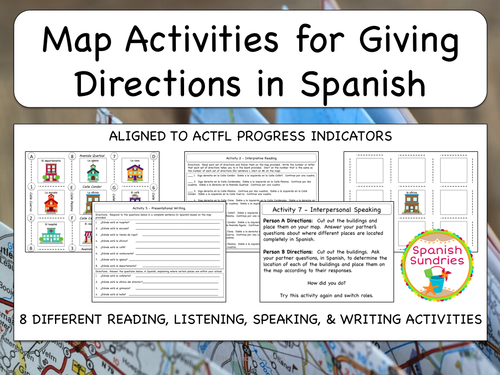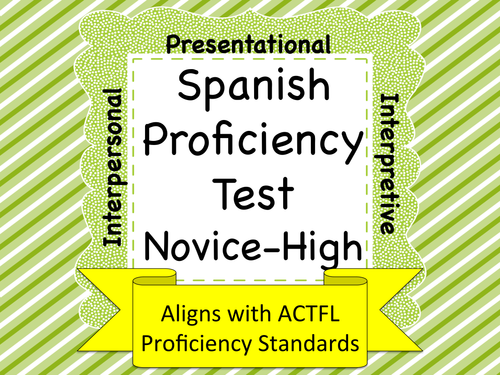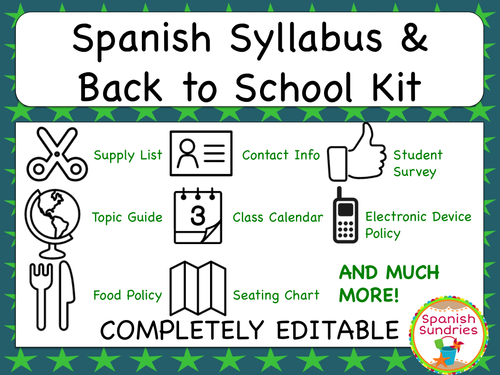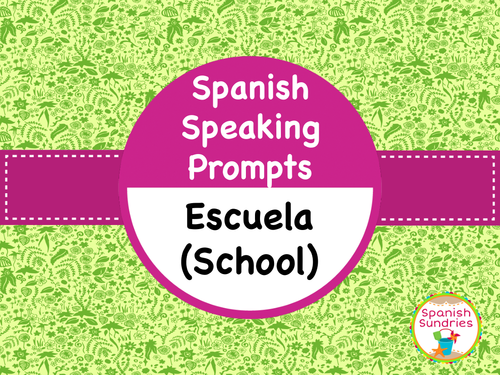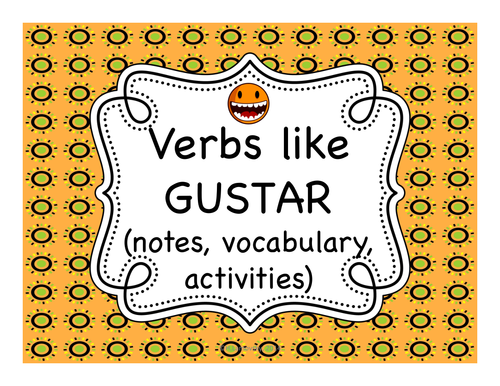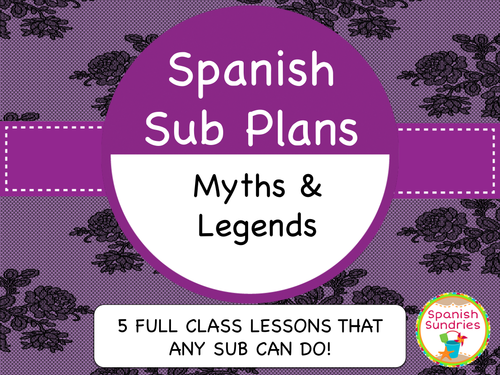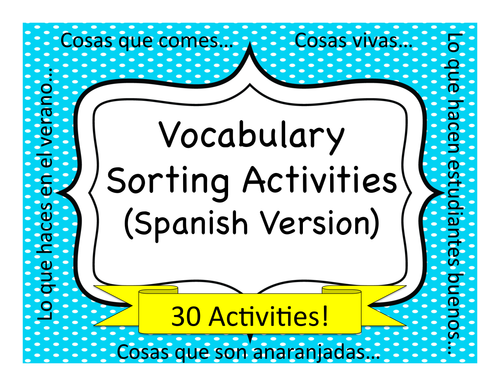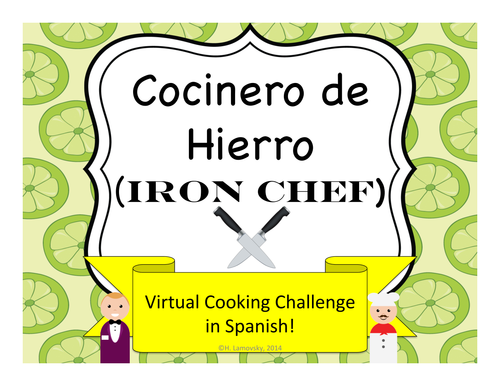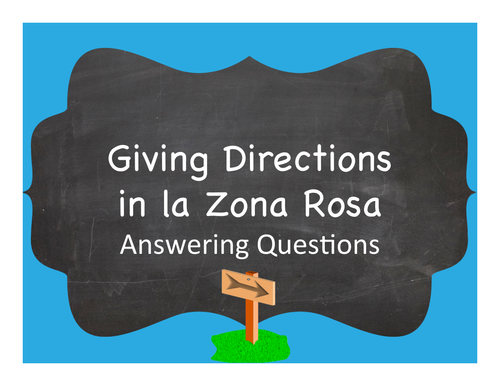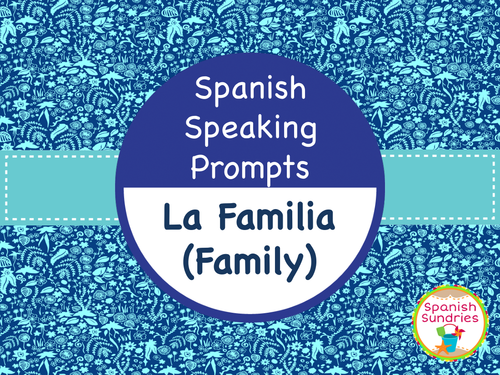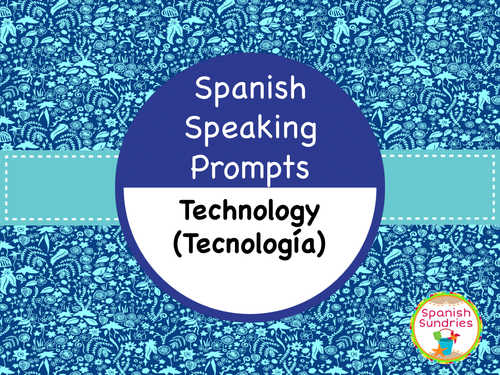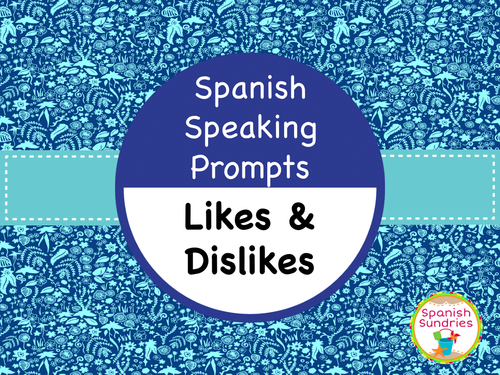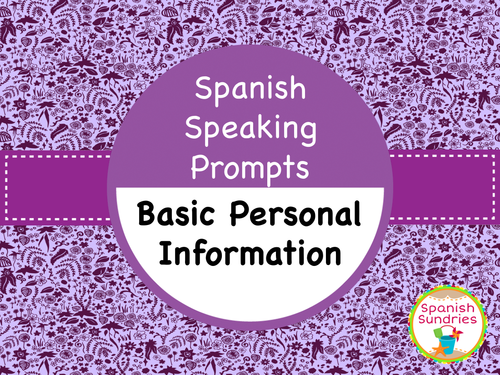
320Uploads
91k+Views
4k+Downloads
World languages

Giving Directions in Spanish Unit
The activities included in this unit will help students to both understand and give driving directions in Spanish. Also included are several activities to teach or review describing the location of a place using directional phrases.
Following this unit, students should be able to meet the following ACTFL progress indicators for Novice-High learners:
-Ask for directions to a place
-Tell someone how to get from one place to another
-Tell someone where something is located
-Give simple directions to a nearby location
-Understand if someone is asking for directions
This unit includes recommended vocabulary as well as 8 different activities centered around the included town maps. The activities focus on all modes of communication including interpretive listening/reading, presentational writing/speaking, and interpersonal speaking. Many of the activities are hands on and allow students to manipulate visuals as they learn. The materials included can be used in a variety of ways throughout many levels of Spanish coursework.
This product includes:
-Guide for Educators
-Vocabulary List
-2 Maps
-Map Cards
-2 Reading Activities
-2 Listening Activities
-2 Writing Activities
-2 Speaking Activities
-Answer Keys for all Objective Activities
-2 Interactive Power Point Activities

Spanish Proficiency or Placement Test: Novice-High
I developed this assessment as a tool for gathering data as to student's proficiency levels during their second and third years of language study in Spanish. This assessment is directly aligned with the ACTFL progress indicators for Novice-High fluency. This assessment addresses all skill areas; Interpersonal Speaking, Presentational Speaking, Presentational Writing, Interpretive Listening, and Interpretive Reading.
This assessment can be used in a variety of ways:
1. As an exit test or final exam for Spanish 2
2. As an entrance exam for Spanish 3
3. As a placement exam for students newly entering your language program from private or out of state institutions
4. As a progress indicator given to students at the beginning, middle, and end of the school year to demonstrate growth
5. As smaller, individual assessments given throughout the course of the school year
This Product Includes:
- Educator's Guide & Instructions for Test Administration
- Resource Links to ACTFL rubrics and progress indicators
- 9 Activities to assess Interpersonal & Presentational Speaking / Writing
- 4 Activities to assess Interpretive Listening
- 5 Activities to assess Interpretive Reading
- Answer Keys for Listening and Reading Activities
- Answer Keys for Writing activities unless answers may vary

Spanish Syllabus $ Back to School Kit
This Spanish Back to School kit includes not only a syllabus, but several other tools you will need to get the year started right as you begin to communicate with students and parents. Better yet, it is completely editable so that you can use it as a template and modify it to meet your own particular needs. It is a great time saver for the busy back to school season.
Everything is in Power Point format and PDF so that it can be printed or projected for orientation nights, open houses, or the first day of classes.
Included in this product:
-Teacher intro
-World Language skill overview
-ACTFL proficiency level overview
-First / Second semester topic guide
-"I Can" statements for Novice Mid and High organized by theme
-Suggested Apps for Spanish class
-Syllabus
-Grading Procedures
-Parent E-mail Contact List
-Seating Chart
-Student Interest & Learning Style Survey
-Weekly Class Calendar
We wish you the best of luck this school year!

Spanish Speaking Prompts - School (Escuela)
These speaking prompts are designed to move students from asking/answering basic questions in Spanish to responding to increasingly complicated prompts around the theme of Escuela (School).
There are 4 categories of prompts that ask students to move between different levels of communication including the presentation of facts, opinions, feelings, and towards complete openness in social situations.
Category A – Yes or No Questions, Either/Or Questions
Category B – Additional Information Questions
Category C – Expressing Opinions and Feelings
Category D – Situational Speaking Prompts & Extended Response
You may approach these prompts by moving students through them from Categories A-D in a sequential manner, or you may use them as an opportunity for easy differentiation between the various proficiency levels of Novice to Intermediate learners that may be present in your classroom.
Although these prompts have been designed as speaking prompts, they can also be used as writing prompts for individual practice, homework, or assessment.
Ideas for Usage:
-Pair students for one on one practice.
-Form small groups and have students interview a student.
-Invite a guest speaker or native speaking student to your classroom and have students select questions to ask them during a Q&A session
-Have students write additional prompts or variations of existing prompts on the blank cards provided
-Pull 1 prompt from each category for a challenging oral proficiency assessment
-Have students develop role plays based on the situational prompts
This Product Includes
-Guide for Educators
-15 Category A Prompts
-15 Category B Prompts
-9 Category C Prompts
-6 Category D Prompts
-Blank Cards to allow for creation of additional questions if desired

Gustar Like/Dislike Unit
This product includes many resources for you to use to help your students improve their interpretive listening, reading, interpersonal speaking, presentational writing, and grammar knowledge of verbs like gustar and likes/dislikes.
This product includes:
1. Vocabulary list (no definitions) with 30 activity phrases common to teens
2. Vocabulary list (with definitions)
3. Four Bell-Ringer or Exit Ticket activities
4. Note handout covering the grammatical structure of sentences with verbs like gustar
5. Grammar Practice Activities
6. Vocabulary Reinforcement Activity
7. Assessment for reading, listening, and vocabulary recognition
8. Scavenger Hunt style speaking activity
9. SpongeBob Squarepants Themed Writing Activity
10. Assessment for grammar application/writing and vocabulary production
11. Answer keys for assessments

Silly Spanish Sentence Writing Activity - Preterite Tense Irregular Verbs
Silly Spanish Sentence Activities are a great way to motivate students and spice up your typical boring grammar drills while building vocabulary.
These activities promote both interpretive reading and presentational writing skills. They provide a structure that will help struggling students while at same time allowing more advanced students to add details according to their abilities. This type of self-differentiation is very helpful in classes where students are at a variety of stages in their fluency and language acquisition.
Students will choose 1 word each from a series of word boxes with the goal of creating funny sentences. They will need to apply grammatical concepts like conjugation and sentence structure while at the same time recognizing key vocabulary items. When they have created 10 sentences, they will choose a favorite and write it on the tear-off section of the activity.
This set of Silly Spanish Sentence activities focuses specifically on preterite tense irregular verbs.
This Product Includes:
-Guide for Educators with Tips and Extension Activity Ideas
-Irregular Verbs Silly Sentence Activity (hacer, venir, querer, estar, andar, tener, poner, poder, etc)
-Irregular Verbs Silly Sentence Activity (ser, ir, dar, traer, producir, conducir, introducir, ver, etc)

Spanish Proficiency or Placement Test: Intermediate-Low
I developed this assessment as a tool for gathering data as to student's proficiency levels during their third and fourth years of language study in Spanish. This assessment is directly aligned with the ACTFL progress indicators for Intermediate-Low fluency. This assessment addresses all skill areas; Interpersonal Speaking, Presentational Speaking, Presentational Writing, Interpretive Listening, and Interpretive Reading.
This assessment can be used in a variety of ways:
1. As an exit test or final exam for Spanish 3
2. As an entrance exam for Spanish 4
3. As a placement exam for students newly entering your language program from private or out of state institutions
4. As a progress indicator given to students at the beginning, middle, and end of the school year to demonstrate growth
5. As smaller, individual assessments or activities given throughout the course of the school year
This Product Includes:
- Educator's Guide & Instructions for Test Administration
- List of ACTFL Progress Indicators addressed
- Resource Links to ACTFL rubrics and progress indicators
- 6 Activities to assess Interpersonal & Presentational Speaking / Writing
- 4 Activities to assess Interpretive Listening
- 4 Activities to assess Interpretive Reading
- Answer Keys for Listening and Reading Activities
- Answer Keys for Writing activities unless answers may vary

Spanish Sub Plans: Hispanic Myths & Legends
These Spanish sub plans can be carried out by any sub while you are out of the classroom. Even better, you won't have to feel guilty that your students aren't learning while you are gone!
This set includes 5 full classes of lessons based on Hispanic myths & legends that are ready to print & go, require no technology, do not require the sub to produce any Spanish, and can be differentiated for any level of Spanish class.
Each lesson walks students through the interpretation of legends from around Latin America including the legends of La Llorona, El Silbón, Los Duendes, El Basilisco Chilote, and El Cadejo.
Students will work step by step to interpret the legends through a series of activities that ask them to relate the legends to present day, make cultural inferences about the purpose and origin of these legends, and compare these legends to their own culture and others. Each lesson asks students to think about the legend in the larger cultural context as they make observations and consider some thought provoking questions.

Spanish Vocabulary Sorting Activities
30 different sorting activities (enough to use roughly once a week during the school year) to help Spanish students make connections between words, brainstorm for writing, or practice new vocabulary. Their versatility, ease of use, and the fact that they differentiate themselves make them one of my favorite things to use in my own classroom!
Each activity contains 4 different categories which students must complete with words that they know and fit each category. These are a quick, easy way for students to recycle vocabulary that they have previously learned or integrate vocabulary they are currently studying.
They can also be used to gauge a student's progress in acquiring language when compared over the school year and they differentiate themselves!
These work well as a class starter or closing activity. Once students have completed an activity, it is easy to use their work as a jumping off point for writing tasks or inspiration for oral drill and conversation.
Use them when you need a sub plan and ask students to write a paragraph or sentences as a follow up activity! These are low prep and ready to print and go! You can even skip the print step and just display them for students!
This is the Spanish Language Version. An English Language Version is also available in my store.

Mexican Independence Day
These activities will allow students to learn about the history and celebration on Mexican Independence Day while acquiring new vocabulary in the target language, strengthening reading skills, and using higher-order thinking skills.
The following is included with this download:
-QR Code and URL links to two videos showing the President's Independence Day "Grito" and a portion of the parade.
-3 Scaffolded Reading Activities with Answer Keys
-1 Compare/Contrast Activity
-1 Creative Writing Activity & Graphic Organizer

Hispanic Myths & Legends: El Silbón
This lesson introduces beginning language learners to the legend of El Silbón (Colombia, Venezuela) in a way that promotes using legends to learn about culture in a deep and meaningful way.
This lesson asks students to consider some complex ideas and make connections between the products, practices, and beliefs of Hispanics around the world. These activities promote higher-level thinking that would be beyond the grasp of most students in the target language, so the lessons are done in English to make sure they are attainable.
These lessons make perfect sub plans as they require no prep and little to no Spanish language production.
Students begin by reading the legend of El Silbón and illustrating the legend to demonstrate comprehension and understanding.
Students are then debriefed on the concept of "Familismo" in Hispanic culture and are asked to reflect on how the characters in the legend display or do not display the traits of "Familismo".
Students are then shown two posters for an event that takes place yearly in Venezuela and references the character "El Silbón". They are asked to assess the posters to draw conclusions about the event and then use that to create an additional poster of their own creation.
Finally, students will read a second and slightly different version of the legend. They will be asked to reflect of how both versions of the story demonstrate the desirable and undesirable behaviors of children in Hispanic culture.
This Product Includes:
-El Silbón Legend (version 1)
-Illustration Activity
-Familismo Activity
-Poster Activity
-El Silbón Legend (version 2)
-Cultural Reflection Activity

Spanish Sub Plans: World Heritage Sites of Latin America
These Spanish sub plans can be carried out by any sub while you are out of the classroom. Even better, you won't have to feel guilty that your students aren't learning while you are gone!
This set includes 5 full classes of lessons based on various World Heritage Sites of Latin America. Each on is ready to print & go, requires no technology, do not require the sub to produce any Spanish, and can be differentiated for any level of Spanish class.
Each lesson walks students through important and interesting information related to a different UNESCO World Heritage Site and asks them to use higher-order thinking skills, problem solving, and critical thinking skills to understand the culture behind that site.
World Heritage Sites addressed in these lessons include:
-Lake Xochimilco (Mexico)
-Tikal National Park (Guatemala)
-Nazca Lines (Perú)
-Qhapaq Ñan & the Andean Road System (Various)
-Cueva de las Manos (Argentina)
Students will work step by step to learn about each site through a series of activities that ask them to use what they have learned and apply it to the present day, make cultural inferences about the purpose and origin of these sites, and compare these sites to their own culture and others. Each lesson asks students to think about the site in the larger cultural context as they make observations and consider some thought provoking questions.
QR codes are also included in many of the lessons (though not required to use) in case your students need extra support. The QR codes, when scanned, will take them to additional information that will help them complete the activities and understand the lesson.
These lessons are fully aligned with the ACTFL cultural competencies for world language learners and also can be used to address several of the culture themes found on the AP Spanish test.

Cocinero de Hierro (Iron Chef) Virtual Food Challenge
Spice up your food unit with this fun group of activities in which students take part in a virtual iron chef style competition. They begin by choosing 3 ingredient playing cards, then they search a Spanish language recipe site for dishes containing those 3 ingredients. Next, they put together a grocery list, breaking down the items they still need by food group to demonstrate comprehension. They answer questions from the judges about the preparation of the dish as they "cook". Finally, they present their dishes to the judges with a drawing/picture and Spanish description of the meal they have prepared.
This Product Includes:
- Guide for Educators
- 40 Ingredient Playing Cards (Print multiple sets for larger classes)
- Instructions for finding recipes containing ingredients on the chosen website
- Food Group Ingredient Sorting Activity
- Judge Q & A Activity
- Dish Presentation Drawing & Writing Activity
This is sure to be a hit with your students! The activity is flexible enough to be done individually, with partners, or in a small group!

"Ay Vamos" por J. Balvin & The Spanish Present Tense (Nosotros Form)
These activities are meant to help students learn how to talk about what "we" do in Spanish using present tense nosotros verb forms.
These activities go along with the song "Ay Vamos" by J. Balvin, a 2015 Latin Grammy award winner for Best Urban Song. This song is readily available on YouTube and iTunes and a link to the song is referenced. These activities may be completed without the music video, so please make sure that the video is appropriate for your students before playing it.
After reviewing a brief biography of J. Balvin, students are asked to listen to the song several times and fill in the lyrics that have been removed. Then, students are given an overview of the concept of the nosotros form in the present tense and asked to complete two inductive grammar activities based on their observations of the song lyrics. Students then are asked to find some additional items within the lyrics of the song in a Lyric Scavenger Hunt activity.
Included in this download:
-Guide for Educators
-Artist Biography
-Link to the song/video on YouTube
-Clozeline Activity
-Nosotros Form Inductive Grammar Activities
-Lyric Scavenger Hunt
-Answer Keys for all objective activities

Giving Directions in La Zona Rosa
In this activity, students use a map of La Zona Rosa in Mexico City to give directions from the hotel they are staying in to many of the tourist attractions in the area. Both the map and activity are included in this download. There is also an additional activity to teach map skills and visual literacy.
A possible extension activity would be to have students research one of the 8 tourist attractions mentioned in this activity.

Spanish Sub Plans: Festivals of Spain
These Spanish sub plans can be carried out by any sub while you are out of the classroom. Even better, you won't have to feel guilty that your students aren't learning while you are gone!
This set includes 5 full classes of lessons based on various festivals that take place in Spain. Each on is ready to print & go, requires no technology, do not require the sub to produce any Spanish, and can be differentiated for any level of Spanish class.
Each lesson walks students through important and interesting information related to a different Spanish festival and asks them to use higher-order thinking skills, problem solving, and critical thinking skills to understand the culture behind that tradition.
Spanish Festivals in these lessons include:
-La Tomatina (Buñol)
-Las Fallas (Valencia)
-Semana Grande (Bilbao)
-Cristianos y Moros
-Bizarre Spanish Festivals
Students will work step by step to learn about each celebration through a series of activities that ask them to use what they have learned and apply it to the present day, make cultural inferences about the purpose and origin of these traditions, and compare these events to events in their own culture and others. Each lesson asks students to think about the festival in the larger cultural context as they make observations and consider some thought provoking questions.
These lessons are fully aligned with the ACTFL cultural competencies for world language learners and also can be used to address several of the culture themes found on the AP Spanish test.

Spanish Speaking Prompts - La Familia (Family)
These speaking prompts are designed to move students from asking/answering basic questions in Spanish to responding to increasingly complicated prompts around the theme of Family (La Familia).
There are 4 categories of prompts that ask students to move between different levels of communication including the presentation of facts, opinions, feelings, and towards complete openness in social situations.
Category A – Yes or No Questions, Either/Or Questions
Category B – Additional Information Questions
Category C – Expressing Opinions and Feelings
Category D – Situational Speaking Prompts & Extended Response
You may approach these prompts by moving students through them from Categories A-D in a sequential manner, or you may use them as an opportunity for easy differentiation between the various proficiency levels of Novice to Intermediate learners that may be present in your classroom.
Although these prompts have been designed as speaking prompts, they can also be used as writing prompts for individual practice, homework, or assessment.
Ideas for Usage:
-Pair students for one on one practice.
-Form small groups and have students interview a student.
-Invite a guest speaker or native speaking student to your classroom and have students select questions to ask them during a Q&A session
-Have students write additional prompts or variations of existing prompts on the blank cards provided
-Pull 1 prompt from each category for a challenging oral proficiency assessment
-Have students develop role plays based on the situational prompts
This Product Includes
-Guide for Educators
-15 Category A Prompts
-15 Category B Prompts
-9 Category C Prompts
-6 Category D Prompts
-Blank Cards to allow for creation of additional questions if desired

Spanish Speaking Prompts - Tecnología
These speaking prompts are designed to move students from asking/answering basic questions in Spanish to responding to increasingly complicated prompts around the theme of Technology.
There are 4 categories of prompts that ask students to move between different levels of communication including the presentation of facts, opinions, feelings, and towards complete openness in social situations.
Category A – Yes or No Questions, Either/Or Questions
Category B – Additional Information Questions
Category C – Expressing Opinions and Feelings
Category D – Situational Speaking Prompts & Extended Response
You may approach these prompts by moving students through them from Categories A-D in a sequential manner, or you may use them as an opportunity for easy differentiation between the various proficiency levels of Novice to Intermediate learners that may be present in your classroom.
Although these prompts have been designed as speaking prompts, they can also be used as writing prompts for individual practice, homework, or assessment.
Ideas for Usage:
-Pair students for one on one practice.
-Form small groups and have students interview a student.
-Invite a guest speaker or native speaking student to your classroom and have students select questions to ask them during a Q&A session
-Have students write additional prompts or variations of existing prompts on the blank cards provided
-Pull 1 prompt from each category for a challenging oral proficiency assessment
-Have students develop role plays based on the situational prompts
This Product Includes
-Guide for Educators
-15 Category A Prompts
-15 Category B Prompts
-9 Category C Prompts
-6 Category D Prompts
-Blank Cards to allow for creation of additional questions if desired

Spanish Speaking Prompts - Likes & Dislikes
These speaking prompts are designed to move students from asking/answering basic questions in Spanish to responding to increasingly complicated prompts around the theme of Likes, Dislikes, and Preferences.
There are 4 categories of prompts that ask students to move between different levels of communication including the presentation of facts, opinions, feelings, and towards complete openness in social situations.
Category A – Yes or No Questions, Either/Or Questions
Category B – Additional Information Questions
Category C – Expressing Opinions and Feelings
Category D – Situational Speaking Prompts & Extended Response
You may approach these prompts by moving students through them from Categories A-D in a sequential manner, or you may use them as an opportunity for easy differentiation between the various proficiency levels of Novice to Intermediate learners that may be present in your classroom.
Although these prompts have been designed as speaking prompts, they can also be used as writing prompts for individual practice, homework, or assessment.
Ideas for Usage:
-Pair students for one on one practice.
-Form small groups and have students interview a student.
-Invite a guest speaker or native speaking student to your classroom and have students select questions to ask them during a Q&A session
-Have students write additional prompts or variations of existing prompts on the blank cards provided
-Pull 1 prompt from each category for a challenging oral proficiency assessment
-Have students develop role plays based on the situational prompts
This Product Includes
-Guide for Educators
-15 Category A Prompts
-15 Category B Prompts
-9 Category C Prompts
-6 Category D Prompts
-Blank Cards to allow for creation of additional questions if desired

Spanish Speaking Prompts - Basic Personal Information
These speaking prompts are designed to move students from asking/answering basic questions in Spanish to responding to increasingly complicated prompts around the theme of Providing Basic Personal Information
There are 4 categories of prompts that ask students to move between different levels of communication including the presentation of facts, opinions, feelings, and towards complete openness in social situations.
Category A – Yes or No Questions, Either/Or Questions
Category B – Additional Information Questions
Category C – Expressing Opinions and Feelings
Category D – Situational Speaking Prompts & Extended Response
You may approach these prompts by moving students through them from Categories A-D in a sequential manner, or you may use them as an opportunity for easy differentiation between the various proficiency levels of Novice to Intermediate learners that may be present in your classroom.
Although these prompts have been designed as speaking prompts, they can also be used as writing prompts for individual practice, homework, or assessment.
Ideas for Usage:
-Pair students for one on one practice.
-Form small groups and have students interview a student.
-Invite a guest speaker or native speaking student to your classroom and have students select questions to ask them during a Q&A session
-Have students write additional prompts or variations of existing prompts on the blank cards provided
-Pull 1 prompt from each category for a challenging oral proficiency assessment
-Have students develop role plays based on the situational prompts
This Product Includes
-Guide for Educators
-15 Category A Prompts
-15 Category B Prompts
-9 Category C Prompts
-6 Category D Prompts
-Blank Cards to allow for creation of additional questions if desired

